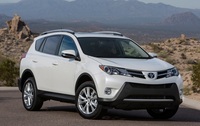2013 Toyota RAV4 Review
By John Heilig
The Auto Page
By John Heilig
The Auto Channel
Model: 2013 Toyota RAV4 Engine: 2.5-liter I4 Horsepower/Torque: 176 hp @ 6,000 rpm/172 lb.-ft. @ 4,100 rpm Transmission: 6-speed manual Wheelbase: 104.7 in. Length x Width x Height: 179.9 x 72.6 x 67.1 in. (with roof rails) Tires: P225/65R17 (LE and XLE) Cargo: 38.4/73.4 cu.ft. (Behind 2nd row/behind 1st row) Economy: 24 mpg city/31 mpg highway Fuel tank: 15.9 gal. Curb wt: 3,435 lbs. (LE) Sticker: $23,300 (LE FWD), $24,290 (XLE FWD), $27,010 (Limited FWD). $1,400 for AWD on all models
Bottom line: The redesigned Toyota RAV4 is sleeker and has more attributes than the model it replaces. Since 1994, when the first RAV4 was introduced, to today with the fourth generation, the RAV4 crossover has kept its position as the preeminent crossover sport utility vehicle with its combination of style and utility.
More than 1.7 million Toyota RAV4s have been sold since the crossover first hit the road in 1994. According to Jim Colon, Toyota's Vice President of Product Development, the new fourth generation model is ready to live up to the company's motto of "Let's Go Places."
The RAV4 may have been the first CUV, but now there are more than 45 available in the industry. "Most mid-size SUVs are really crossovers," according to Colon.
The new RAV4 has a completely new look from the old. Toyota calls it "visually dynamic." For one, the spare tire has been relocated from the rear door to under the cargo floor. This allows for a lift gate rather than the swinging door on the previous model. This, in turn, makes for a much better looking tailgate. On the Limited, there's a power adjustable lift gate with memory. Cargo capacity is an enormous 38.4 cubic feet with the rear seats upright (2.0 more than previously), and a cavernous 73.4 cubic feet with them dropped.
The RAV4 now incorporates projector beam headlamps that help reduce the coefficient of drag from .334 to .329. This isn't a lot, agreed, but it helps reduce wind noise and improve fuel economy.
While a V6 engine was available previously, only a 2.5-liter inline four now powers the RAV4. In our test ride, this was enough. Toyota feels that if you can't live without the six, you will move up to the Highlander. The engine develops 176 horsepower, and while the route we chose didn't allow us to stretch the RAV4's legs, we did drive it over a wide assortment of road surfaces with varying degrees of straightness.
I and my co-driver both felt that the RAV4 was a good driver with very good ride quality. The suspension, fairly standard all around, was not harsh nor too soft, or, as the Toyota reps bragged, "just right, like the little bear in the Goldilocks story."
We both felt that the four-cylinder engine, while it had enough power, was about as noisy as a standard four-banger, and quite noisy when you tromp down on the accelerator. The 6 speed transmission serves the RAV4 well.
All-wheel drive is available on all three versions of the RAV4 for an additional $1,400. Toyota expects AWD to account for approximately 30 percent of RAV4 sales.
Our test ride in the base LE front-wheel drive model (starting price, $23,300) brought out many of the virtues of the RAV4. I was favorably impressed with the interior styling. Among the four interior color combinations, the designers use "color blocking" to differentiate between the driver's side of the car and the front passenger's side. The soft touch two-tone dash is attractive with stitching between the two leather-like surfaces. In the top-end XLE and Premium grades, "French stitching" is used, but we thought the non-French stitching was fine.
There's an ECO/Sport button located low to the left of the dash that changes the shift characteristics of the transmission. The steering wheel has a "DISP" button that cycles through various screens to show fuel economy, etc.
The front seats are comfortable, as are the rears. In the back, there's really only room for two passengers, but that's fine. The rear seats recline. All the seats are designed to reduce whiplash injury in rear-end crashes. In addition, there are eight air bags.
Even our base LE was well equipped. For example, we had a back-up camera that gave us a good view of what was behind us. On the Limited model only, Blind Side Alert and Rear Cross Traffic Alert are available options. Jeff Harley from the University of Toyota explained that it is a supply issue more than anything else. Apparently there is only one supplier for the industry of a BSM/RCTA package.
Display audio is standard on all three grades. This means that the "navi screen" will tell you what's playing, and anyone who has experienced SiriusXM or an iPod will appreciate this feature. There's also a simple three-knob HVAC system. On the upper two models, it's a two-zone HVAC system.
The RAV4 has a cubby at the base of the center stack that has the USB connection. The center console and trim pieces have a carbon fiber look that works well.
We were told that RAV4 engineers concentrated on reducing NVH (noise, vibration and harshness) in the new RAV4, and they succeeded. Aerodynamic considerations concentrated on the flow around the mirrors, for example. They also use an acoustic windshield that reduces wind noise.
Toyota expects to sell around 200,000 RAV4s in 2013, and the vehicle has done well since its January introduction. Some of the ads we saw are certain to help sales.
(c) 2013 The Auto Page



